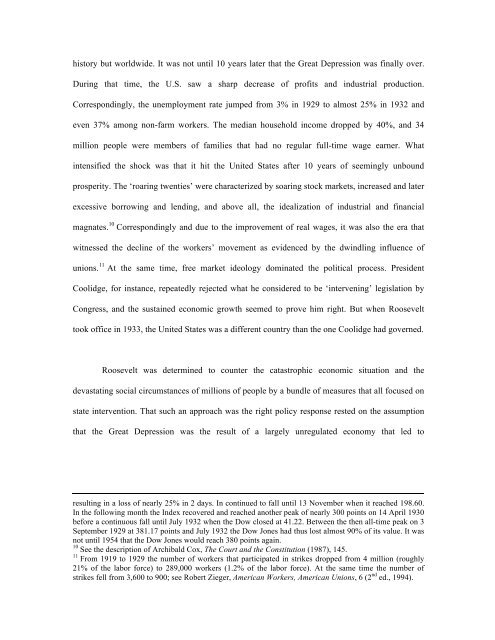Jasper Finke, Crisis and Law - New York University School of Law
Jasper Finke, Crisis and Law - New York University School of Law
Jasper Finke, Crisis and Law - New York University School of Law
You also want an ePaper? Increase the reach of your titles
YUMPU automatically turns print PDFs into web optimized ePapers that Google loves.
history but worldwide. It was not until 10 years later that the Great Depression was finally over.<br />
During that time, the U.S. saw a sharp decrease <strong>of</strong> pr<strong>of</strong>its <strong>and</strong> industrial production.<br />
Correspondingly, the unemployment rate jumped from 3% in 1929 to almost 25% in 1932 <strong>and</strong><br />
even 37% among non-farm workers. The median household income dropped by 40%, <strong>and</strong> 34<br />
million people were members <strong>of</strong> families that had no regular full-time wage earner. What<br />
intensified the shock was that it hit the United States after 10 years <strong>of</strong> seemingly unbound<br />
prosperity. The ‘roaring twenties’ were characterized by soaring stock markets, increased <strong>and</strong> later<br />
excessive borrowing <strong>and</strong> lending, <strong>and</strong> above all, the idealization <strong>of</strong> industrial <strong>and</strong> financial<br />
magnates. 10 Correspondingly <strong>and</strong> due to the improvement <strong>of</strong> real wages, it was also the era that<br />
witnessed the decline <strong>of</strong> the workers’ movement as evidenced by the dwindling influence <strong>of</strong><br />
unions. 11 At the same time, free market ideology dominated the political process. President<br />
Coolidge, for instance, repeatedly rejected what he considered to be ‘intervening’ legislation by<br />
Congress, <strong>and</strong> the sustained economic growth seemed to prove him right. But when Roosevelt<br />
took <strong>of</strong>fice in 1933, the United States was a different country than the one Coolidge had governed.<br />
Roosevelt was determined to counter the catastrophic economic situation <strong>and</strong> the<br />
devastating social circumstances <strong>of</strong> millions <strong>of</strong> people by a bundle <strong>of</strong> measures that all focused on<br />
state intervention. That such an approach was the right policy response rested on the assumption<br />
that the Great Depression was the result <strong>of</strong> a largely unregulated economy that led to<br />
resulting in a loss <strong>of</strong> nearly 25% in 2 days. In continued to fall until 13 November when it reached 198.60.<br />
In the following month the Index recovered <strong>and</strong> reached another peak <strong>of</strong> nearly 300 points on 14 April 1930<br />
before a continuous fall until July 1932 when the Dow closed at 41.22. Between the then all-time peak on 3<br />
September 1929 at 381.17 points <strong>and</strong> July 1932 the Dow Jones had thus lost almost 90% <strong>of</strong> its value. It was<br />
not until 1954 that the Dow Jones would reach 380 points again.<br />
10 See the description <strong>of</strong> Archibald Cox, The Court <strong>and</strong> the Constitution (1987), 145.<br />
11 From 1919 to 1929 the number <strong>of</strong> workers that participated in strikes dropped from 4 million (roughly<br />
21% <strong>of</strong> the labor force) to 289,000 workers (1.2% <strong>of</strong> the labor force). At the same time the number <strong>of</strong><br />
strikes fell from 3,600 to 900; see Robert Zieger, American Workers, American Unions, 6 (2 nd ed., 1994).
















